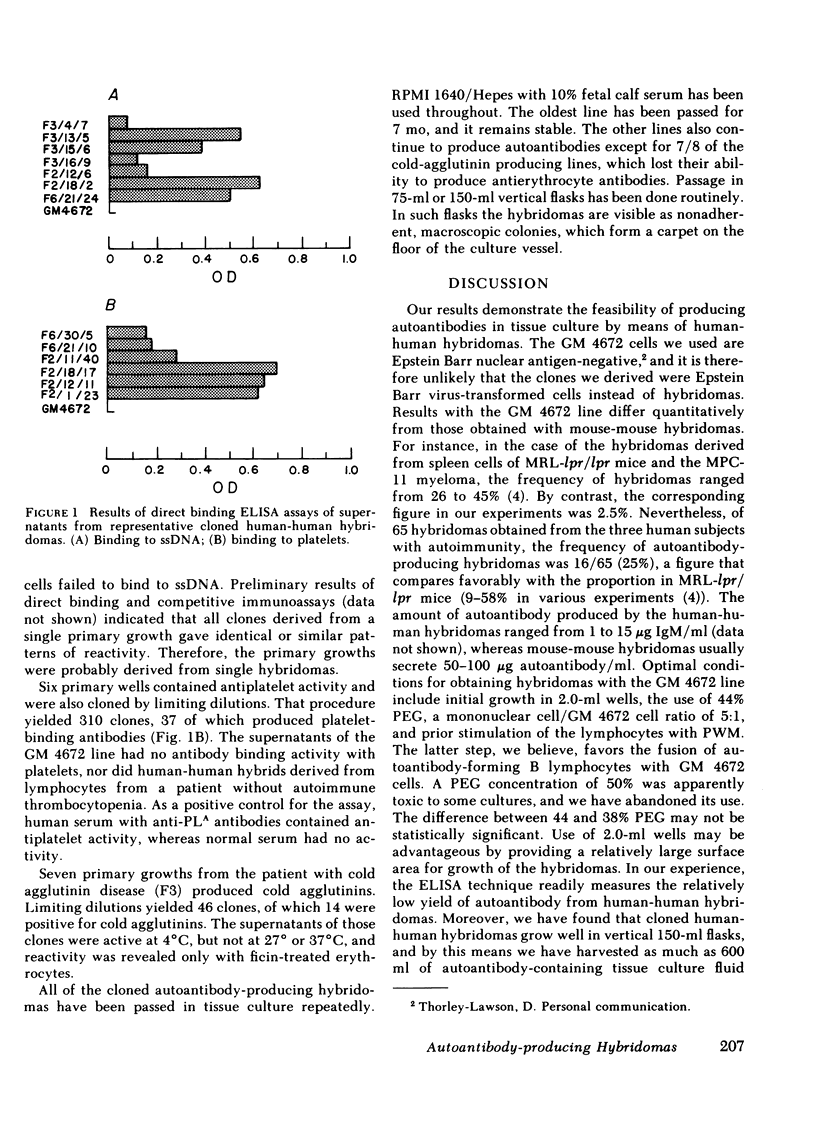Abstract
Peripheral blood lymphocytes and splenocytes of patients with autoimmune disease were used to prepare human-human hybridomas that produce autoantibodies. Because exogenous immunization was not used, the hybridoma antibodies were derived from B cells that spontaneously produced autoantibodies. 108 hybrids grew from 4,254 wells (2.5%). Optimal conditions for obtaining hybridomas with the GM 4672 myeloma line included initial growth in 2-ml wells, the use of 44% polyethylene glycol, a mononuclear cell/GM 4672 cell ratio 5:1, and prior stimulation of the B lymphocytes with pokeweed mitogen. Hybridoma supernatants had activity against ssDNA, platelets, and erythrocytes. The results demonstrate the feasibility of producing human-human hybridomas from lymphocytes of patients with various autoimmune diseases.
Full text
PDF



Selected References
These references are in PubMed. This may not be the complete list of references from this article.
- Andrzejewski C., Jr, Stollar B. D., Lalor T. M., Schwartz R. S. Hybridoma autoantibodies to DNA. J Immunol. 1980 Mar;124(3):1499–1502. [PubMed] [Google Scholar]
- Croce C. M., Linnenbach A., Hall W., Steplewski Z., Koprowski H. Production of human hybridomas secreting antibodies to measles virus. Nature. 1980 Dec 4;288(5790):488–489. doi: 10.1038/288488a0. [DOI] [PubMed] [Google Scholar]
- DeHeer D. H., Pages J. M., Bussard A. E. Specificity of antierythrocyte autoantibodies secreted by a NZB-derived hybridoma and NZB peritoneal cells. Cell Immunol. 1980 Jan;49(1):135–141. doi: 10.1016/0008-8749(80)90063-5. [DOI] [PubMed] [Google Scholar]
- Eilat D., Asofsky R., Laskov R. A hybridoma from an autoimmune NZB/NZW mouse producing monoclonal antibody to ribosomal-RNA. J Immunol. 1980 Feb;124(2):766–768. [PubMed] [Google Scholar]
- Gefter M. L., Margulies D. H., Scharff M. D. A simple method for polyethylene glycol-promoted hybridization of mouse myeloma cells. Somatic Cell Genet. 1977 Mar;3(2):231–236. doi: 10.1007/BF01551818. [DOI] [PubMed] [Google Scholar]
- Klotz J. L., Phillips M. L., Miller M. M., Teplitz R. L. Monoclonal autoantibody production by hybrid cell lines. Clin Immunol Immunopathol. 1981 Mar;18(3):368–374. doi: 10.1016/0090-1229(81)90130-6. [DOI] [PubMed] [Google Scholar]
- LITTLEFIELD J. W. SELECTION OF HYBRIDS FROM MATINGS OF FIBROBLASTS IN VITRO AND THEIR PRESUMED RECOMBINANTS. Science. 1964 Aug 14;145(3633):709–710. doi: 10.1126/science.145.3633.709. [DOI] [PubMed] [Google Scholar]
- Lerner E. A., Lerner M. R., Janeway C. A., Jr, Steitz J. A. Monoclonal antibodies to nucleic acid-containing cellular constituents: probes for molecular biology and autoimmune disease. Proc Natl Acad Sci U S A. 1981 May;78(5):2737–2741. doi: 10.1073/pnas.78.5.2737. [DOI] [PMC free article] [PubMed] [Google Scholar]


